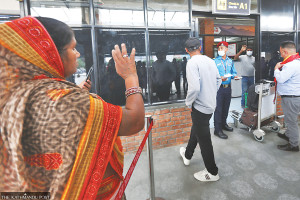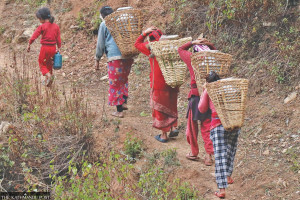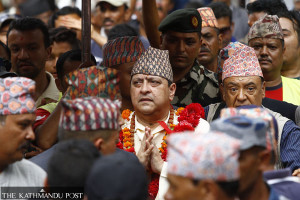 22.12°C Kathmandu
22.12°C KathmanduMiscellaneous
If you build it, they’ll come
The Bhairahawa-Lumbini-Butwal corridor is set to become a major international transit, transport and tourism hub
Prahlad Rijal
Merely 10 years ago, the Bhairahwa-Lumbini-Butwal corridor was heavily reliant on industries; with its proximity to the Indian border being one of the only advantages it had over other sleepy settlements in the Tarai. Local residents confide that at the time proper road networks and other infrastructure were lacking and economic mobility had been stymied to a snail’s pace compared to other major cities in the nation. Yet today, as you drive on the six-lane-highway that links Butwal to Bhairahawa, the recent transformation which the area has undergone is conspicuous. The corridor buzzes with activity, the movement of goods and raw materials from the border into the towns have gained pace and new houses are sprouting in areas which were previously disregarded as wastelands.
Recently, substantial investment has been channelled into the Bhairahawa-Lumbini-Butwal corridor and as a result, the region has been experiencing exponential growth and development. The corridor was once considered just another border town. Today, it is booming, and its soaring land prices pay testament to its positive economic trajectory.
“The region is experiencing a significant boost in infrastructural development,” says Bishnu Dutta Gautam, chief executive officer of the Siddharthanagar Municipality. “This is a major factor that is pushing our economy towards modernisation and increasing revenue generation through planned urbanisation, trade and the promotion of tourism.”
Playing by strength
Siddharthanagar Municipality, also known as Bhairahawa, is a gateway to Lumbini, a hub for Buddhist tourism. In order to draw pilgrims and visitors to the religious site, stakeholders plan to transform the domestic airport in Bhairahawa into a regional international airport spread over 715 bighas of land by 2018. The ambitious Gautam Buddha International Airport project, expected to come into operation in 2018, aims to bring in 553,020 passengers annually to the region by 2023.
Along with the airport other investments follow as well. According to local officials, investment has started flowing into the construction of five-star hotels and other hospitality establishments in the corridor.
“A five-star hotel is under construction at Buddha Chowk in the municipality while another group has finished its building plan and is due to file an application,” says Shailendra Shrestha, senior engineer of planning at the municipality.
“The Bhairahawa-Lumbini-Butwal corridor is a crucial economic zone with more than 16 manufacturing industries. Proximity to the Indian border and Lumbini’s heritage sites are major advantages,” Ananda Pandey, a local businessman said, “We have been able to realise satisfactory growth in the region and the ongoing construction works will add to the newly found revival.”
Also, the government and the Asian Development Bank (ADB) have drawn plans to prioritise the development of the region with the Trade Route Improvement Project, Integrated Urban Development Project (IUDP) and South Asia Tourism Infrastructure Development Project (SATIDP).
“The region is a special zone because of the potential it carries,” said Kennichi Yokoyama, the ADB country director, “The growth prospects in the region is high as mega projects like the airport will help to boost tourism, increase revenue and generate employment opportunities.”
The ADB has thus far provided $58.50 million ($42.75 million in loans and $15.75 million in grants) under the SATIDP to build the airport. Likewise, the Opec Fund for International Development (OFID) has provided a loan of $15 million and the Civil Aviation Authority of Nepal (CAAN), which is executing the project, has funded the rest.
A town reborn
Along with the airport, Bhairahawa is seeing other infrastructural reforms as well, with the flood management systems now in place being hailed as an important upgrade. Local stakeholders have termed the construction of the 32 km of primary drainage and inner city roads as a game changer.
“Siddharthanagar used to be a flood-prone zone and swaths of land would be inundated every monsoon making it impossible to commute,” Bishnu Maya Rokka, a local senior citizen, recalls, “After the construction of drainage systems, the flooding problem has been eliminated and the construction of houses has increased.” “The land prices has jumped sevenfold here in the past two years alone,” adds Shrestha, “A couple of years ago, 10 dhur of land was valued at Rs 1,500,00 but these days the same land is being traded at Rs 6,500,00 to Rs 7,000,00.”
The construction of inner-city infrastructure in Bhairawa—under the IUDP—started in 2012 and is expected to be completed by 2017. Funding of $17.18 million has been allocated under loans and grants for the overall infrastructural development of the area. The second phase of construction—additional drains and 25 km of paved roads—is slated to commence as well.
“We have finished the first phase of the construction project and the flooding issue has been resolved, opening the way for real estate development,” said Shrestha, “Five out of 13 wards have seen a massive rise in land plotting.”
Three years ago, the municipality received around 100 applications for building permits annually, according to Shrestha. The figure has jumped several folds to 600 during this fiscal year, with revenue collection from housing permits crossing an all time high of Rs 10 million.
Making connections
Along with the inner-city infrastructure, construction of the Butwal-Belhiya trade road is gathering steam. The six-lane highway links the trade hub of the region, Butwal, to the Indian border (Belhiya), which is 24 km further down south.
The Butwal-Belhiya road project was launched in 2011-12 after repeated complaints from the residents and business houses that the local infrastructure no longer supported the booming population and commerce. So far, 11.50 km of the road has been completed, accounting for 49 percent of the Rs 5.5 billion project.
Furthermore, Siddharthanagar Highway has emerged as a crucial lifeline for the area. The 181-km-long highway extends to the Indian border at Sunauli and connects tourist hotspots of Siddharthanagar, Butwal, Tansen and Pokhara. The airport construction is expected to not only promote Lumbini, but also other major tourist spots and settlements in the area because of the road connectivity.
Leading the way
“The region has bright prospects of becoming a mega city or a satellite city in the Rupandehi district,” says Gautam, “Within 10 years Bhairahawa will outperform other cities in the Tarai, if everything goes according to plan.”
With mega cities and satellite towns as well as talk of provincial capitals gathering momentum, the Bhairawa-Butwal corridor is emerging as a vibrant, notable example for other regional stakeholders. Unlike many other towns that have mushroomed overnight, Siddharthanagar has refused to put the cart ahead of the horse—with its planning and foresight already bearing fruit. And now, with evolving and expansive infrastructure acting as bedrock to their community, there is no telling what great heights they’re destined for.











.jpg&w=300&height=200)



